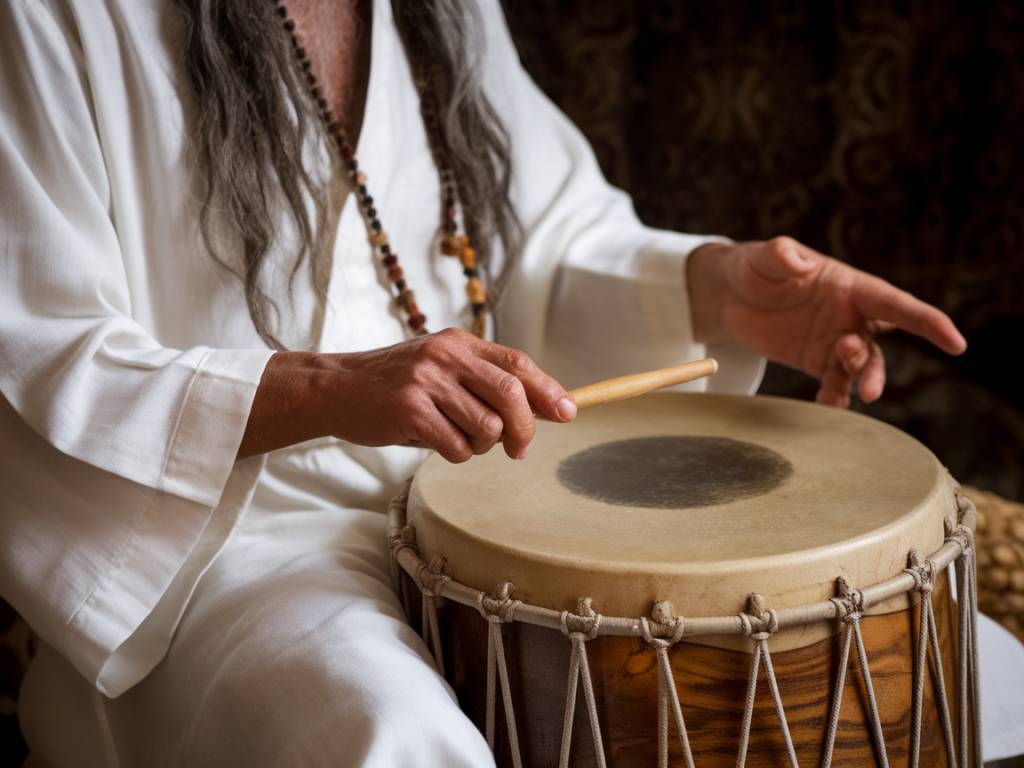Sound healing, an ancient practice employed by various cultures worldwide, has seen a resurgence in recent years. Central to this practice is the concept of rhythm, a fundamental component that guides the therapeutic process. This article delves into the role of rhythm in sound healing, exploring its scientific basis, historical context, and practical applications.
The Science Behind Rhythm and Healing
Sound healing operates on the principle that sound vibrations can influence our physical and mental well-being. Rhythm, a recurrent pattern of sound or movement, plays a crucial role in this therapeutic approach. Research in neuroscience and psychology has shown that rhythmic patterns can affect brainwave frequencies, which in turn can alter our state of consciousness.
The human brain typically operates at different frequencies depending on the state of mind:
- Delta waves (0.5 to 4 Hz): Deep sleep
- Theta waves (4 to 8 Hz): Light sleep, meditation
- Alpha waves (8 to 12 Hz): Relaxed, calm
- Beta waves (12 to 30 Hz): Active thinking, alertness
- Gamma waves (30 Hz and above): High-level information processing
Rhythmic sound patterns can induce changes in these brainwave patterns, promoting relaxation, focus, and even healing at a cellular level. Studies have shown that certain rhythmic frequencies can help reduce stress, alleviate pain, and improve cognitive function.
Historical Context of Rhythm in Sound Healing
Rhythm has been a cornerstone in various traditional healing practices. In Indigenous cultures, drumming ceremonies have been used for centuries to connect individuals with their inner selves and the community. The repetitive, rhythmic beats are believed to synchronize with the body’s natural rhythms, promoting healing and spiritual awakening.
In ancient Greece, the philosopher Pythagoras employed musical intervals and rhythmic patterns to treat physical and emotional ailments. Similarly, in Indian Ayurvedic medicine, rhythmic chants and mantras are integral to healing rituals, aimed at balancing the body’s energy centers, or chakras.
These historical practices underscore the enduring significance of rhythm in sound healing across cultures and time periods.
Modern Applications of Rhythmic Sound Healing
Today, sound healing practitioners employ various instruments and techniques to harness the power of rhythm. Some of the most commonly used tools include:
- Drums: The repetitive beats of drums can induce trance-like states, aiding in stress relief and spiritual connection.
- Tuning Forks: These instruments produce specific frequencies that can be applied to different parts of the body, promoting physical healing and energy balancing.
- Singing Bowls: Often used in meditation, the harmonic tones and rhythms of singing bowls can facilitate deep relaxation and emotional healing.
- Chanting and Mantras: Vocal sound patterns and rhythms can help focus the mind, reduce anxiety, and enhance overall well-being.
The Mechanisms of Rhythmic Healing
Understanding how rhythmic sound influences the body and mind involves a closer look at several mechanisms:
- Entrainment: This phenomenon occurs when the rhythm of external stimuli, such as sound, influences the body’s internal rhythms. For example, a slow, steady drumbeat can slow down heart rate and breathing, promoting relaxation.
- Resonance: Rhythmic sound waves can create resonant frequencies that vibrate through the body, potentially releasing physical blockages and restoring energetic balance.
- Synchronization: Brainwave entrainment occurs when rhythmic sounds induce changes in brainwave states, helping to achieve targeted mental states, such as relaxation or heightened focus.
The Therapeutic Impact of Rhythm in Sound Healing
Sound healing sessions often incorporate rhythmic elements to achieve specific therapeutic outcomes:
- Stress Reduction: Rhythmic patterns can lower cortisol levels and induce a sense of calm, making them effective in reducing stress and anxiety.
- Pain Management: The vibrations and rhythmic beats can stimulate the release of endorphins, the body’s natural painkillers, providing relief from chronic pain conditions.
- Enhanced Cognitive Function: Rhythmic sounds can improve focus and concentration, making them beneficial for those with ADHD or cognitive impairments.
- Emotional Healing: Rhythmic chanting and drumming can facilitate emotional release and foster a sense of connection and well-being.
How to Incorporate Rhythmic Sound Healing in Everyday Life
For those interested in exploring rhythmic sound healing, there are several accessible practices to incorporate into daily routines:
- Meditative Drumming: Participate in or listen to drumming circles to connect with rhythmic patterns and promote relaxation.
- Tuning Fork Therapy: Use tuning forks to target specific areas of the body, employing rhythmic vibrations for physical and energetic balance.
- Singing Bowl Meditation: Engage with singing bowls to produce harmonic and rhythmic tones that facilitate a meditative state.
- Chanting Mantras: Integrate rhythmic chanting into meditation practices to enhance focus and emotional well-being.
Choosing Rhythmic Sound Healing Instruments
When selecting instruments for rhythmic sound healing, consider the following factors:
- Purpose: Identify the primary goal, such as relaxation, emotional healing, or physical pain relief, to choose the most appropriate instrument.
- Quality: Invest in high-quality instruments to ensure the best therapeutic outcomes.
- Personal Resonance: Choose instruments that resonate with you on a personal level to enhance the effectiveness of the practice.
Popular choices for rhythmic sound healing instruments include:
- Native American Drums: Known for their deep, resonant beats, these drums are ideal for grounding and spiritual connection.
- Crystal Singing Bowls: These bowls produce clear, pure tones that can facilitate deep emotional and energetic healing.
- Tibetan Singing Bowls: Traditional bowls often used in meditation, providing harmonic and rhythmic soundscapes.
- Chakra Tuning Fork Sets: Designed to target specific energy centers, these sets offer precise rhythmic frequencies for holistic healing.
Understanding the role of rhythm in sound healing reveals its profound impact on physical, emotional, and spiritual well-being. By exploring the scientific foundations, historical contexts, and practical applications, individuals can harness the power of rhythm to enhance their healing journeys. Whether through drumming, tuning forks, singing bowls, or chanting, incorporating rhythmic sound healing into daily life offers a powerful avenue for achieving balance and harmony.

